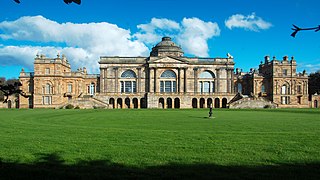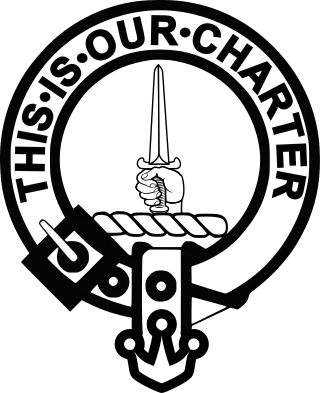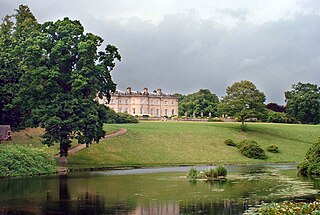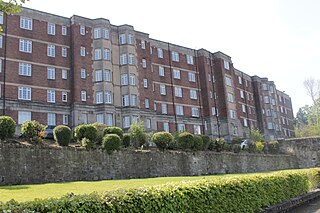
Amisfield House was a substantial Palladian mansion near Haddington, East Lothian.

Amisfield House was a substantial Palladian mansion near Haddington, East Lothian.
Previously known as Newmills, under that name in the 17th century, the previous estate was the site of the murder of Sir James Stanfield, whose family had come to Scotland after the Union of 1606. In November 1687 Sir James was found dead in the pond on the estate. At first thought to have been drowned an autopsy in a local church by Edinburgh surgeons showed that he had been strangled. As the family prepared to re-bury the corpse his nephew Philip Stanfield handled the corpse and was aghast when the body spilt blood onto both hands. In those days of witchcraft this was interpreted as a sign of guilt. Philip was put on trial at the High Court in Edinburgh on 7 February 1688. Despite any clear evidence he was found guilty. [1]
The land was later purchased by Lady Anne Douglas and she changed the name of Newmilns to Amisfield after her ancestral home Amisfield Tower in Dumfriesshire. [2] An original (smaller) estate house was built on the East Lothian estate, east of Haddington, around 1700. [3]
The 18th century house was the creation of Francis Charteris, second son of James Wemyss, 5th Earl of Wemyss. The family became estranged from much of Scottish society when his elder brother, David, Lord Elcho chose to back the Jacobite cause, and Bonnie Prince Charlie and, as a result of the Jacobite defeat at the Battle of Culloden in 1746 David was ineligible to inherit the estate and on the death of the 6th Earl in 1756 Francis was instead the heir. Having done a "Grand Tour" of Europe, he chose to rebuild the old house at Amisfield in the Palladian style. He commissioned the English architect Isaac Ware to design the house, due to his skill in the Palladian style. It faced north onto the River Tyne but had a formal south frontage facing the garden and broader estate. [4] The walled garden (with cylindrical corner towers) was created in 1758 by John Henderson. [5]
Charteris commissioned architect John Henderson (d.1786) in 1784 to update some interiors and add some features in the landscape. Most importantly, it was Henderson who added the continuous balustrade around the perimeter of the roof, and adding curved ramps in place of steps on the north frontage. Plasterwork dating from 1784 included work by James Nisbet in the dining room and other principal rooms. Henderson was also commissioned to create architectural features in the walled garden and other buildings around the estate (see below). [6]
While works progressed Charteris relocated to a newly purchased estate: Gosford House on the Firth of Forth, which he enjoyed the additional pleasure of a nearby golf links. When Amisfield was ready, he commissioned Robert Adam to remodel Gosford. [7]
Francis Charteris died in 1808 (and was buried on his Gosford estate). The estate then passed to his eldest son, Francis Charteris (1749-1808). The family vacillated between Gosford and Amisfield until 1883 when the treasures of Amisfield were transferred to Gosford. The family rented the house for some years, but the vast house was beyond almost all, and the house went into decline. [8]
Amisfield was abandoned in 1925 and demolished 1928/9. The Edinburgh architect Stewart Kaye was involved in making a photographic record of the house prior to demolition. The huge grounds of the house were partly used to create Amisfield Park and partly for Haddington Golf Club. The land closest to Haddington was used for new housing. [9] The gardens (publicly accessible under the name Amisfield Park) remain substantially intact. [10]

Earl of Wemyss is a title in the Peerage of Scotland created in 1633. The Scottish Wemyss family had possessed the lands of Wemyss in Fife since the 12th century. Since 1823 the earldom has been held with the Earldom of March, created in 1697. The holder of the title is sometimes known as the Earl of Wemyss and March, but the titles are distinct.

Musselburgh is the largest settlement in East Lothian, Scotland, on the coast of the Firth of Forth, five miles east of Edinburgh city centre. It has a population of 21,100.

The Royal Burgh of Haddington is a town in East Lothian, Scotland. It is the main administrative, cultural and geographical centre for East Lothian. It lies about 17 miles east of Edinburgh. The name Haddington is Anglo-Saxon, dating from the sixth or seventh century AD when the area was incorporated into the kingdom of Bernicia. The town, like the rest of the Lothian region, was ceded by King Edgar of England and became part of Scotland in the tenth century. Haddington received Burgh status, one of the earliest to do so, during the reign of David I (1124–1153), giving it trading rights which encouraged its growth into a market town.

Francis David Charteris, 12th Earl of Wemyss and 8th Earl of March, styled Lord Elcho from 1916 to 1937, was a Scottish peer, landowner and conservationist. From 1946 to 1991, he served as chairman and then president of the National Trust for Scotland.
Francis Wemyss Charteris was a Scottish landowner who claimed to be 7th Earl of Wemyss.
Haddingtonshire was a Scottish county constituency represented in the House of Commons of Great Britain and the House of Commons of the United Kingdom from 1708 to 1918.

Gosford House is a neoclassical country house around 2 miles (3 km) northeast of Longniddry in East Lothian, Scotland, on the A198 Aberlady Road, in 5,000 acres (2,000 ha) of parkland and coast.
John Cockburn of Ormiston, East Lothian, was a Scottish landowner and politician who sat in the Parliament of Scotland from 1702 to 1707 and as a Whig in the British House of Commons for 34 years from 1707 to 1741.

Colonel Francis Charteris, nicknamed "The Rape-Master General", was a Scottish soldier and adventurer who earned a substantial sum of money through gambling and the South Sea Bubble. He was convicted of raping a servant in 1730 and sentenced to death, but was subsequently pardoned, before dying of natural causes shortly afterwards.

Clan Charteris is a Scottish clan of the Scottish Lowlands.

Morham, East Lothian, sometimes spelt Moram, Morum, or Morhame in old records, is the smallest (agricultural) parish in Scotland, sandwiched between five other parishes: Haddington, Garvald, Yester, Whittingehame, and Prestonkirk, in the undulating lower reaches of the Lammermuir Hills.

The Collegiate Church of St Mary the Virgin is a Church of Scotland parish church in Haddington, East Lothian, Scotland.

Redhouse Castle is a ruined tower house castle, 2 km east of Longniddry, East Lothian, Scotland, UK, on the B1377, close to Spittal. The castle designated as a scheduled monument. It is no longer protected as a category A listed building.

Mavisbank is a country house outside Loanhead, south of Edinburgh in Midlothian, Scotland. It was designed by architect William Adam in collaboration with his client, Sir John Clerk of Penicuik, and was constructed between 1723 and 1727. The first Palladian villa in Scotland, it is described by Historic Scotland as "one of Scotland's most important country houses." It was altered in the 19th century, but suffered decades of neglect in the 20th century. The interiors were gutted by fire in 1973, and the house remains a ruin, described by Colin McWilliam in 1978 as a "precarious shell.". In 2024, a grant of £5.3 million was given to stabilise the building and to enable up-to-date surveys of its condition to be made.

Yester House is an early 18th-century mansion near Gifford in East Lothian, Scotland. It was the home of the Hay family, later Marquesses of Tweeddale, from the 15th century until the late 1960s. Construction of the present house began in 1699, and continued well into the 18th century in a series of building phases. It is now protected as a category A listed building, and the grounds of the house are included in the Inventory of Gardens and Designed Landscapes in Scotland, the national listing of significant gardens.

James Donald Charteris, 13th Earl of Wemyss and 9th Earl of March,, also known as Jamie Neidpath, is a British peer and landowner.
Francis Wemyss Charteris, Lord Elcho was a Scottish nobleman and member of parliament.

Estate houses in Scotland or Scottish country houses, are large houses usually on landed estates in Scotland. They were built from the sixteenth century, after defensive castles began to be replaced by more comfortable residences for royalty, nobility and local lairds. The origins of Scottish estate houses are in aristocratic emulation of the extensive building and rebuilding of royal residences, beginning with Linlithgow, under the influence of Renaissance architecture. In the 1560s the unique Scottish style of the Scots baronial emerged, which combined features from medieval castles, tower houses, and peel towers with Renaissance plans, in houses designed primarily for residence rather than defence.

Stewart Kaye FRIBA FRICS (1885–1952) was a Scottish architect in the 20th century. Working in a stripped down Scottish version of the Art Deco style he was consultant architect to the Presbytery of East Lothian and the Halifax Building Society. Mainly based in Edinburgh he is responsible for a large proportion of the city's housing estates from the 1930s.